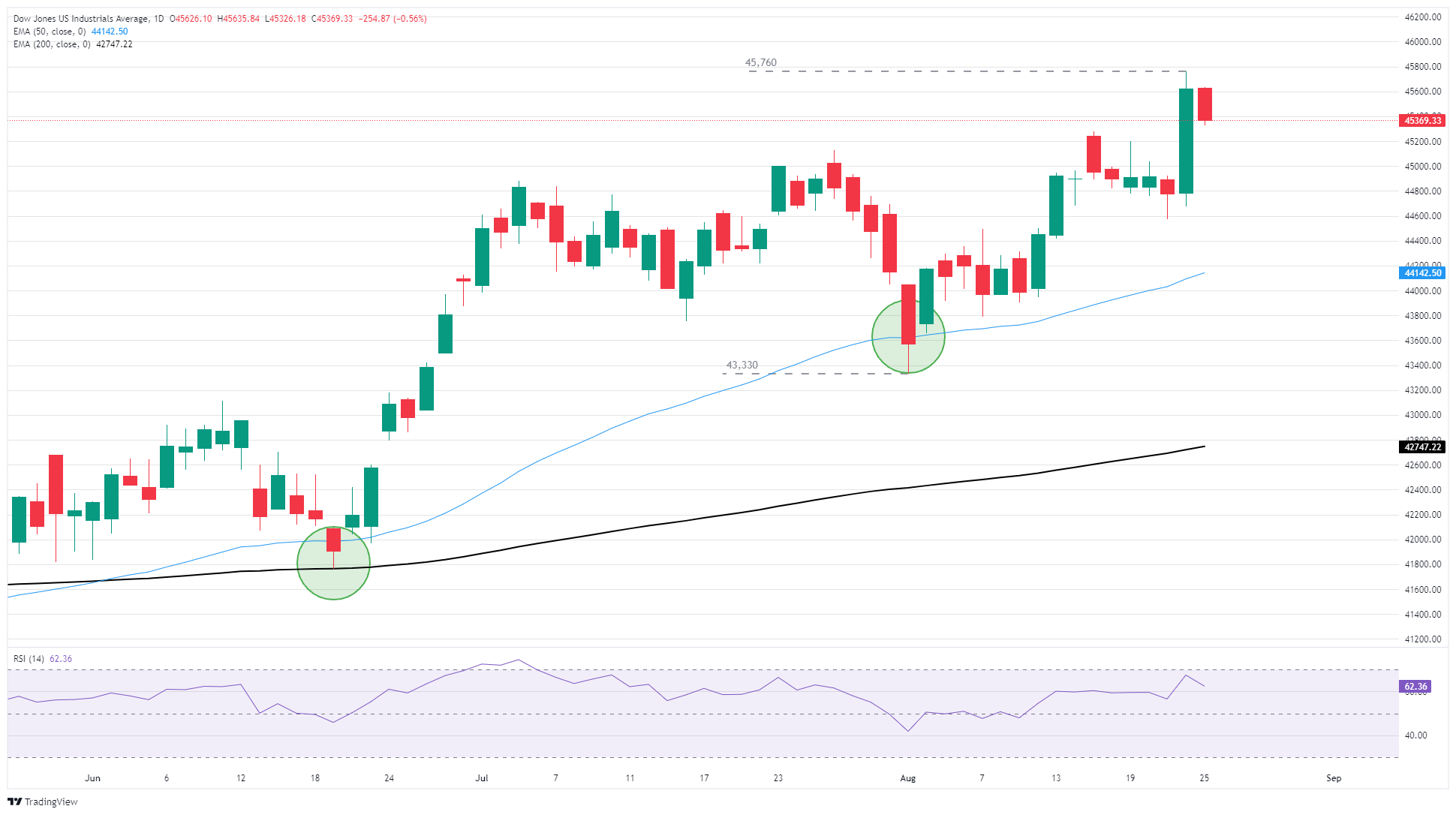Dow Jones Industrial Average eases back from record highs
- The Dow Jones backslid on Monday from all-time peak last Friday.
- Investor sentiment remains high, but market has trimmed a little off the top.
- A quiet start to the week gives way to the latest batch of US inflation data.
The Dow Jones Industrial Average (DJIA) saw a slight decline on Monday, with the major equity index easing back from record highs posted last week. Market exuberance at what investors are broadly interpreting as a dovish appearance from Federal Reserve (Fed) Chair Jerome Powell has given way to a sedate start to the week as investors brace for the latest round of key US inflation data.
Jerome Powell’s appearance at the Jackson Hole Economic Symposium sent global markets scrambling to ramp up bets of an interest rate cut on September 17. According to market participants, Fed Chair Powell gave a far more dovish speech than many had expected. To the Fed head’s credit, despite the special occasion calling for some extra verbiage, very little of Powell’s testimony strayed very far from the standard “data dependent” speech notes that have circled the Fed over the past year.

With Jackson Hole now fading into memory, investors are pivoting to face a dangerous week: US Durable Goods Orders, Gross Domestic Product (GDP) growth, and Personal Consumption Expenditure Price Index (PCE) inflation. The key data release this week will be PCE inflation, which is slated for Friday. Markets are still betting that the Fed will be more concerned about rapidly declining US job figures than near-term inflation effects when the Fed’s next interest rate call rolls around on September 17.
However, any unpleasantness in this week’s PCE inflation print could throw a hard wrench into the works. Despite very real concerns that the US labor market is softening much faster than many expected, a sharp upswing in inflation will still be more than enough to push Fed policymakers deeper into their long-running wait-and-see approach before making any hard calls on moving rates.
Dow Jones daily chart

Dow Jones FAQs
The Dow Jones Industrial Average, one of the oldest stock market indices in the world, is compiled of the 30 most traded stocks in the US. The index is price-weighted rather than weighted by capitalization. It is calculated by summing the prices of the constituent stocks and dividing them by a factor, currently 0.152. The index was founded by Charles Dow, who also founded the Wall Street Journal. In later years it has been criticized for not being broadly representative enough because it only tracks 30 conglomerates, unlike broader indices such as the S&P 500.
Many different factors drive the Dow Jones Industrial Average (DJIA). The aggregate performance of the component companies revealed in quarterly company earnings reports is the main one. US and global macroeconomic data also contributes as it impacts on investor sentiment. The level of interest rates, set by the Federal Reserve (Fed), also influences the DJIA as it affects the cost of credit, on which many corporations are heavily reliant. Therefore, inflation can be a major driver as well as other metrics which impact the Fed decisions.
Dow Theory is a method for identifying the primary trend of the stock market developed by Charles Dow. A key step is to compare the direction of the Dow Jones Industrial Average (DJIA) and the Dow Jones Transportation Average (DJTA) and only follow trends where both are moving in the same direction. Volume is a confirmatory criteria. The theory uses elements of peak and trough analysis. Dow’s theory posits three trend phases: accumulation, when smart money starts buying or selling; public participation, when the wider public joins in; and distribution, when the smart money exits.
There are a number of ways to trade the DJIA. One is to use ETFs which allow investors to trade the DJIA as a single security, rather than having to buy shares in all 30 constituent companies. A leading example is the SPDR Dow Jones Industrial Average ETF (DIA). DJIA futures contracts enable traders to speculate on the future value of the index and Options provide the right, but not the obligation, to buy or sell the index at a predetermined price in the future. Mutual funds enable investors to buy a share of a diversified portfolio of DJIA stocks thus providing exposure to the overall index.

